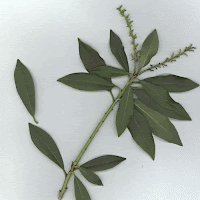Every discipline has its jargon, which provides a common language
for understanding and communicating. Botany is no exception. In order to
identify a plant, you must be able to observe and describe it. Trees, shrubs,
vines, and plants are similar in that they typically have some sort of root,
stem, leaf, inflorescence or flower, and fruit; but the variations and
combinations are vast. Botanical terms provide the language for observation and plant identification, but, as with other disciplines, there are differences in interpretation
and historical usage.
I frequently turn to Plant
Identification Terminology An Illustrated Glossary by James G. Harris and Melinda
Woolf Harris, published by Spring Lake Publishing, Utah (second edition, 2001).
The book includes a glossary of about 2400 terms and supporting illustrations, and
is divided into two parts. Part one is an alphabetical glossary of the terms; part
two is organized into categories: roots, stems, leaves, surfaces, inflorescences,
flowers, and fruits. The leaves section alone spans 17 pages, with descriptions of leaf
parts, shapes, bases, apices, division, venation, margins, attachment, and arrangement.
To get the full picture you need to delve into the surfaces section, which spans another 9 pages. And leaves are easy compared with flowers and inflorescences!
I can look to my own small garden to see the diversity of plants,
and practice the art and science of describing plants. As I learn more, I'm sure my descriptions will change and become more precise. In the meantime, the exercise forces me to really look at a plant and its parts, and stretch my descriptive vocabulary.














No comments:
Post a Comment